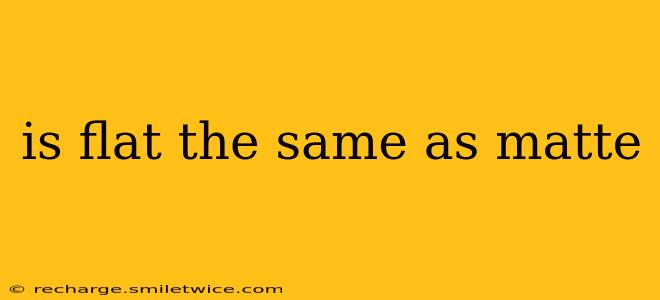Is Flat the Same as Matte? Understanding Paint Finishes
The terms "flat" and "matte" are often used interchangeably when discussing paint finishes, leading to confusion. While they share similarities, there are key differences that impact the final look and durability of your painted surface. This article will delve into the nuances of these finishes, helping you choose the right one for your project.
What is a Flat Paint Finish?
Flat paint, also known as matte paint, has a completely non-reflective surface. This means it absorbs light rather than reflecting it. The result is a very smooth, low-sheen appearance, often described as velvety or soft. This lack of sheen is what makes it popular for walls where imperfections are less noticeable. However, this very characteristic is also its biggest drawback – it is not as durable or washable as other finishes.
What is a Matte Paint Finish?
Matte paint has a very low sheen, significantly lower than satin or semi-gloss, but it possesses a subtle, almost imperceptible reflection of light. It's often described as having a soft, elegant look. While still less durable than higher-sheen paints, matte finishes usually offer slightly better washability and scrubbability than true flat paints. The difference in durability and washability between matte and flat is often subtle, depending on the specific paint brand and formulation.
What's the Key Difference Between Flat and Matte?
The primary difference lies in the level of sheen, albeit a very small one. Flat paint is entirely non-reflective, while matte paint has a minuscule amount of sheen. This minute difference can be hard to detect with the naked eye, especially on large surfaces. However, the slight sheen in matte paint can make it a bit more practical in areas prone to dirt or moisture, offering marginally improved cleanability.
Is Matte Paint More Durable Than Flat Paint?
Generally, yes. Matte paint's slightly higher sheen often translates to a slightly more durable finish, making it slightly more resistant to scuffs and scratches than a true flat paint. This increased durability also usually results in better washability. However, both flat and matte finishes are still less durable than eggshell, satin, or semi-gloss options.
Which Finish Should I Choose for My Walls?
The best choice depends on the room and your priorities. For areas with low traffic and minimal wear and tear, a flat or matte finish can create a beautifully smooth and elegant look. Bedrooms or dining rooms are good candidates. However, for high-traffic areas like hallways, kitchens, or bathrooms, a more durable eggshell or satin finish would be a better choice. Remember to consider the color of your paint, as darker colors will show imperfections more readily on a flat or matte finish.
How Easy is it to Clean Flat and Matte Paint?
Both flat and matte finishes are relatively delicate. While a damp cloth might suffice for minor cleaning, aggressive scrubbing or harsh chemicals can damage the paint's surface. For tougher stains, you might need professional cleaning, or consider a more durable finish in high-traffic areas.
Can I Use Flat or Matte Paint on Trim?
While it's possible, it's generally not recommended. Trim receives more wear and tear than walls, and flat or matte finishes lack the durability needed to withstand regular cleaning and potential impacts. For trim, a semi-gloss or high-gloss finish is more suitable for its greater resistance to damage and easier cleaning.
In conclusion, while often used interchangeably, flat and matte paint finishes have subtle differences in sheen and durability. Understanding these nuances will help you choose the best finish to achieve your desired aesthetic while considering the practical needs of the space you are painting. Remember to always check the specific paint manufacturer's instructions and recommendations for cleaning and care.
